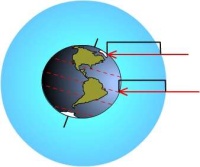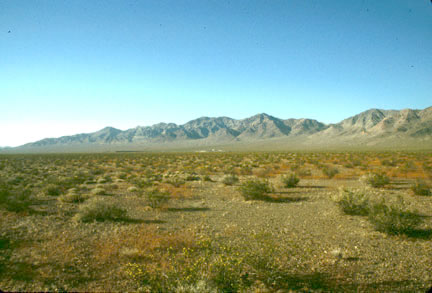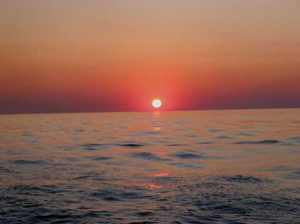Path length and InsolationThe distance a beam of light travels affects the amount of solar energy that ultimately reaches the Earth. Light spreads outward in all directions when it is emitted from the Sun. As the light spreads, its intensity upon reaching distant locations decreases. The intensity of light decreases as the square of the distance between the Sun and receptor increases, a relationship known as the inverse square law. The Earth receives about one-half of one billionth of the Sun's total output of energy.
Figure 4.15 Influence of atmospheric path length on insolation The Earth-Sun distance only varies by about 3 million miles compared to an average distance of 93 million miles over the year. Thus path length doesn't change much as the Earth revolves around the Sun. But once sunlight reaches the outer edge of the atmosphere, the thickness of the atmosphere has a significant impact on insolation. Due to the curvature of the Earth, a beam of light striking the Equator passes through less atmosphere than one at a higher latitude. As the amount of atmosphere through which the beam passes increases, the greater the chance for reflection and scattering of light to occur, thus reducing insolation at the surface.
State of the Atmosphere and InsolationClouds, particulates, and aerosols suspended in the air have a dramatic effect on the transmission of insolation. These components of the atmosphere absorb radiation emitted by the earth, reflect incoming solar radiation back to space and scatter light into many weaker beams. Scattering of light by particles in the atmosphere is responsible for the color of the sky. Clouds are particularly important in determining the amount of insolation. Clouds can reflect much light back to space or scatter and diffuse light.
|
|
Figure 4.16 The brilliant blue sky over the Amargosa Desert, Nevada is caused by the scattering of all but blue wavelengths. Courtesy USGS. Source |
Figure 4.17 Scattering of red wavelengths creates this gorgeous sunset over the ocean. Being on the horizon, the pathlength is longer creating a greater chance for scattering light. Courtesy of the NOAA ESRL Chemical Sciences Division, Boulder, Colorado, USA. Source |
Assess your understanding of the preceding material by "Looking Back: Energy and Radiation" or skip and continue reading. |
|

This work is licensed under a Creative Commons Attribution-ShareAlike 4.0 International License..



